Capua, Campania 16th June
Driving south from Rome in the late afternoon we stopped in ancient Capua. A ruined amphitheatre dominates the centre of this run down Campanian village, otherwise distinguished only by a prison. New Capua, with its domed cathedral, is a haughty distance away. The original Capua, however, was immortalized in Livy as the city whose luxury sapped the fighting quality of Hannibal’s troops. It was also from here that Spartacus led his revolt of gladiators in 73 BC. Presumably the training school run by Peter Ustinov in the 1950s Kubrick movie and John Hannah in the more recent TV series ‘Blood and Sand’ was somewhere close to the very well preserved amphitheatre. We took delight in imagining our hero battling in this very arena. Perhaps it was on these sands that Kirk Douglas in the movie was forced to kill his best friend in front of a laughing crowd, thus sowing in his mind the first seeds of rebellion. Naturally my daughter and I launched furiously into a sword fight, which we resumed at sunset on the deck of our boat as it steamed out of Naples.
(Please click on thumbnails below to scroll through the galleries in this post:)
-
Gladiators at sea
(photo by Hong Ying)
-
Gladiators on land
(photo by Hong Ying)
- Memories of Spartacus
We should by rights be reacting to amphitheatres with horror. They were built as places of blood and slaughter solely for popular entertainment – but there is no denying their beauty, especially in the slanting decline of a summer day. It is a good thing that in cities like Verona and Macerata, amphitheatres are now venues for opera, and closer to my home in Le Marche the little wooded glade that was once the coliseum of ancient Urbs Saglia has become the stage for Greek plays – nature and art combining together to heal the traumas of the past.
Erice, Sicilia 17th June
Abandoning Palermo as soon as we disembarked we made our way west via pristine beaches on the northwest of the island to the mountain top town of Erice. This was the ancient Eryx, famous all over the world for its temple to Venus Ericina (Aphrodite in her incarnation of ‘impure love’, goddess of prostitutes). For hundreds of years pilgrims (men and women) flocked here from all over the Roman Empire. The shrine that gleamed from its high rock (the temple could be seen by mariners from miles out to sea) was torn down and replaced by a Saracen fort (one wonders if the devout Muslim garrisons ever knew of the dark and erotic ceremonies that once took place on the rock where they were praying). Later, next to the Saracen fort, the Normans constructed a fine castle of the crusader style, as well as Romanesque churches in Erice’s narrow streets and squares.
-
Clouds and history
(photo by Hong Ying)
- Saracen and Norman castles over a sex goddess’s shrine
A different sort of pilgrim comes today – tourists wishing to see the impressive fortifications and monuments and to try the spaghetti al sarde in Erice’s restaurants, and in winter come the medical conventions and such like, who find being above the clouds conducive to clear, scientific thought. Times and Erice have changed. Nevertheless, this precipitous mountain with its godlike view does still retain some of the aura of ancient mysteries. And like the clouds floating over the panorama below, one feels wafted by the diverse filaments that wove the historical tapestry of the island – Sicel, Phoenician, Greek, Roman, Arab, Norman. The old castles still look over the plain to Trapani, which was once a Carthaginian colony; it’s now a stronghold of the Mafia. In the words of Ovid, who might even have come to the Venus Ericina temple (it was his sort of thing): Omnia mutantur, nihil interit.
Palermo, Sicilia 18th June
The Americans with their bombers and the Mafia they re-installed did a thorough job of keeping Sicily’s grand old lady of a capital in a state of genteel poverty and decay for half a century. The city is still pockmarked by WW2 bombsites and worse the cheap Mafia housing has spread all over the plain like weeds. It is tragic, because once, under the Arabs and Normans, Palermo was a world capital, a paradise of gardens and hunting parks, later the glittering court of the Emperor Frederick II, who was called “stupor mundi” – the wonder of the world. It has taken continuous resolve and extraordinary levels of bravery on the part of Italian officials to fight the corrupt malaise that for years throttled Palermo, and there is still a long way to go (we saw some of the poverty and hopelessness in the queues of parents and sick children locked out of the emergency ward of the Children’s Hospital – strict triage applies, unless one has a back door …). But over the last decade the fine monuments have been gradually emerging in splendour again: glorious Monreale on its hilltop, the Duomo, the exquisite Cappella Palatina with its golden mosaics and stunning Cristo Pancreator, the Norman hunting lodges and the remains of Lampedusa’s fin de siècle grandeur- the theatres, the faded palazzos (some of that lifestyle lingers in the breakfast room of the Hotel Centrale) as well as the great ornamental fountains and statues, now clean and white again in the bright light, their soot and shabbiness washed away. Perhaps we came closest to the old Palermo in the puppet shows, in which knights and Saracens, exquisitely carved and coloured, clomp through the traditional epics of the troubadours in a delightful romp of art, magic, history and tragedy – with it goes without saying a healthy dose of irrepressible, earthy Sicilian humour to anchor us to the ground.
- Puppet magic
- Master puppeteers
- Monreale
- Palermo street
- Palermo street
(All Palermo photos by Hong Ying)
Selinunte, Sicilia 19th June
The central highlands of Sicily are one great wheat field interspersed with strange gigantic rocks that look as if they have fallen from space. Sometimes a lonely Norman castle looks down from a crag, but for hours one drives through emptiness. Despite the fertile soil and abundant crops, here is a gaunt beauty, tinged of course with sadness, because for most of Rome’s history these same fields were worked until they died by slaves who had been brought from every corner of the empire to ensure the supply of grain to the Eternal City. It is a relief to see the blue sea again on the south of the island – not that this coast was spared cruelties over the ages, even in the days of the Greek colonies that first brought civilization and trade to the island – for they also brought war. Syracuse, its greatest pride, was the home of the scientist and philosopher, Archimedes. It was also the city of Greece’s worst tyrant, Dionysius, who preyed on his neighbours with more viciousness than any invader. Yet the little that remains of those old colonies are magnificent. I cannot think of an architectural site in Greece or Turkey that matches Selinunte for lonely grandeur, grace and melancholy.
- Broken pillars
- Selinunte
Villa Piazza Armerina, Sicilia, 20th June
Well preserved mosaics in the Roman villa at Piazza Armerina provide an interesting diversion on the road to Syracuse.
- Roman beach sports
- Bedroom scene
To be continued…
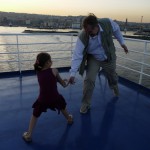
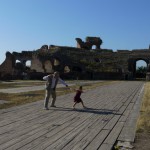
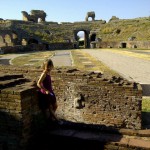
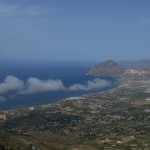
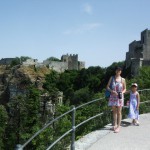
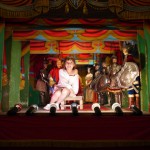
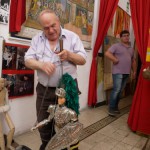
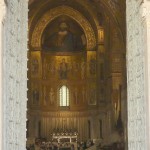
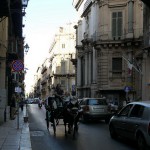
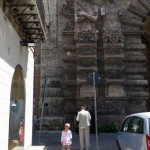
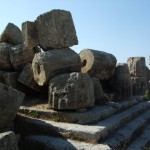
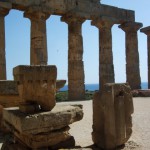
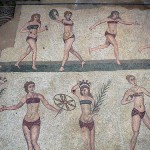
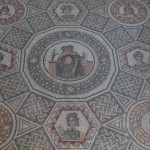


So interested to read your comments on both Puglia and Sicily. We’ve been twice to Puglia (art tours) and this last to Sicily. Loved it so much we want to go back again! Next trip is to Calabria with an amazing art historian. We both survive!